Managing customer relationships is one of the most important aspects of business. Customer relationship management software (CRM) streamlines this process, but what is CRM, and how does it work?
Understanding how to manage customer interactions effectively is key, as it directly impacts your business’s growth and success.
In this post, we’ll answer, what is CRM? We’ll also explore the important aspects of customer relationship management, like how to choose a CRM solution, and how to set it up for your business.
So read on to find out what is CRM.
What is CRM? Quick Overview
CRM stands for customer relationship management.
When someone asks what is CRM or talks about CRM, they are referring to one of three things:
- CRM Software: The platform or solution teams use to track the relationship between their company and customers/prospects.
- CRM Strategy: A detailed plan that dictates how a business will interact with customers and prospects, and manage customer relationships.
- CRM Process: A system that a business adopts to help manage customer relationships and nurture leads.
For most businesses, the process of managing customer relations is so intertwined with the tool that CRM is often used to refer to both.
But first, what is CRM, and why are we talking about CRM?
Customer relationship management software (CRM) is one of the fastest-growing technologies for businesses today and is set to change the business landscape. According to Statista, the market for CRM technology is set to reach $58.7 billion by 2026.
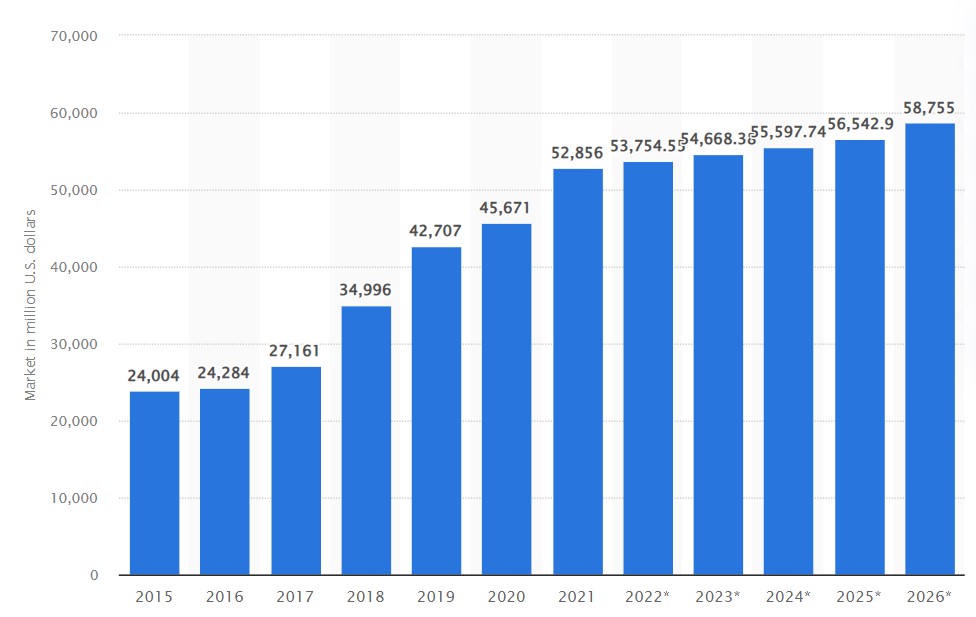
Image via Statista
It’s not something you can ignore anymore. If you haven’t invested in a good CRM platform yet, then it’s about time that you do! This post will not only answer what is CRM but also help you make the right choice.
What is CRM Software?
You can’t fully understand what is CRM without discussing what CRM software is.
CRM software is a platform that connects the different teams within your organization and integrates all their customer-related activities into one cohesive system. In other words, it collects all the customer information available within your company and collates it to form a holistic picture.
With a CRM in place, your marketing, sales, customer service, and other teams can access real-time client data for better customer interactions.
That means that anyone who wants to learn more about a particular customer can see their entire journey of interacting with your company.
Most CRM systems, by the way, work on cloud computing and SaaS technologies; more on that later.
First, you need to understand what is CRM and then who users of CRM technology are.
Who Should Use CRM Software?
Now that we’ve answered the “What is CRM?” question, you should understand who the typical users of a CRM platform are.
The short answer is that all businesses can and should use CRM tools to manage and improve customer relationships.
Given that every business needs to maintain good customer relationships as a matter of survival, customer relationship management is useful for all businesses, irrespective of their type and size.
One common myth is that the only businesses that invest in CRM softwares are the ones that can afford them. That, however, is not true.
With cloud-based CRM systems, there are numerous options that fit varying budgets. You can opt for affordable and scalable CRM solutions that grow with your business.
Start with something that meets your basic needs, and upgrade as you record business growth.
How Does a CRM Software Solution Work?
Even if you have a basic understanding to answer the “What is CRM?” question, you might still find yourself asking this question:
How to use a CRM solution and what are its capabilities?
Well, a CRM solution collects customer data from various customer touchpoints within your organization and combines that to form a holistic picture of each customer.
The most common sources for customer data are the sales and marketing departments.
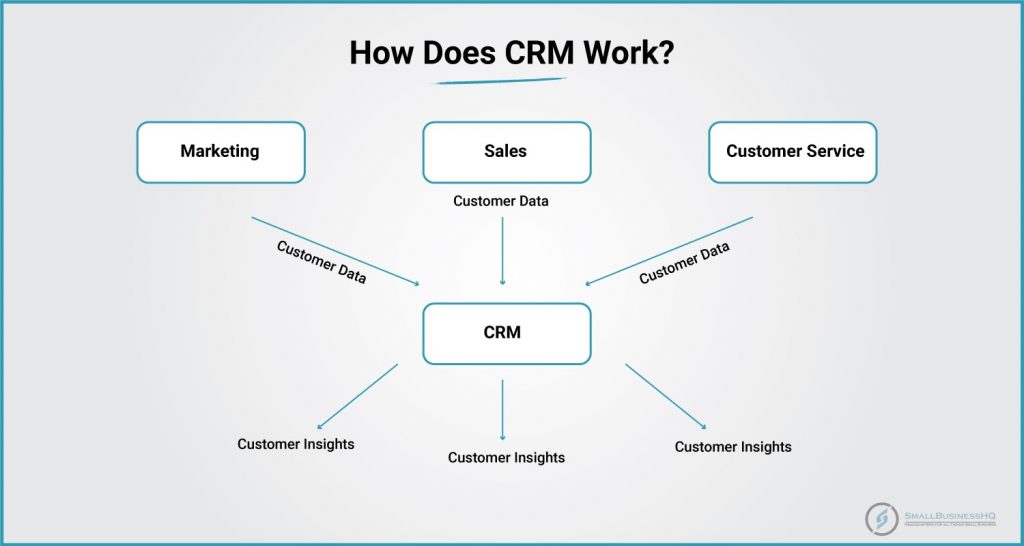
CRM tools don’t just collect data but also analyzes it to provide actionable insights. Your employees can use these insights to better interact with your customers and provide a delightful user experience.
So what features can you expect to find in your typical CRM software? Here’s a list.
- A reporting and analytics dashboard
- Data management, automation, and segmentation features
- Marketing and sales automation
- Client database containing detailed customer profiles
- Customer behavior tracking across channels like websites and ecommerce stores
- AI and ML tools to predict and suggest the best action for teams
With the above CRM features, businesses of all shapes and sizes can reap lots of benefits across their departments. For instance:
- Sales teams can better manage their sales pipeline and track deals.
- Marketing teams can get more visibility over leads and improve personalization.
- Customer service teams can manage their customer communications better across channels.
- HR teams can use customer relationship management software to better track employee performance.
The next section discusses some specific CRM benefits that businesses can get.
Also Read:
What Are the Basic Goals of CRM?
It’s not enough to know what is CRM, understanding the basic goals of a CRM is essential for any business looking to streamline processes and improve customer relationships.
Answering Basic Customer Questions
Nobody likes waiting forever for answers. Whether it’s a question about a product, an order, or support, quick responses keep customers happy. So, what is CRM and how can it help answer customer questions?
CRM stores customer history, allowing businesses to quickly access details without making customers repeat themselves. With all the information in one place, teams can provide faster, more personalized service, leading to higher customer satisfaction.
Personalize Marketing Campaigns
Generic ads don’t always work. Personalizing marketing campaigns involves tailoring content, offers, and messages to individual customer preferences and behaviors to increase engagement and conversions. CRM helps businesses send the right message to the right people.
It tracks past purchases, browsing habits, and customer preferences. This prevents the business from wasting time sending irrelevant offers and generic emails to everyone on the subscription list. Instead, it ensures targeted communication reaches the right audience.
Managing Customer Data
Another advantage of using CRM is its ability to manage customer data. So, what is CRM? It’s a system that collects, organizes, and stores information like contact details, order history, and support requests, helping businesses understand preferences and enhance customer experiences.
With everything neatly organized and easily accessible, customer service teams always know where they stand with each customer, making follow-ups seamless and more effective.
Automating the Sales Process
CRM takes care of repetitive tasks like scheduling follow-ups, sending reminders, and logging interactions. That way, teams can focus on closing deals instead of managing administrative tasks.
Automated workflows ensure that no lead is overlooked. It enables businesses to close deals more quickly and efficiently.
Aligns Sales and Marketing
Sales and marketing teams often work in silos, leading to miscommunication. CRM bridges this gap by aligning both teams, allowing marketing to track which leads convert into sales. This also provides the sales teams with deeper insights into customer behavior.
With shared data, both teams can adjust strategies based on real results. This leads to improved communication, more effective campaigns, and ultimately, increased sales over time.
What are the Benefits of Using a CRM Solution?
Wondering what the point is of investing in a CRM platform when you’re perfectly capable of managing customer relationships yourself?
No matter how good you are at handling customers, from a business perspective, it’s always better to keep things extra organized to improve customer satisfaction.
Though you may be excellent at dealing with customers, you can’t possibly remember each customer and their past interactions with your business.
Also, as your business grows, there are so many repetitive tasks you’ll need to automate. So what is CRM and what are the benefits of using a CRM solution?
Customer relationship management solutions can help you keep track of each customer and deliver the kind of personalized service that’s unmatched by any other competitor.
And that’s just scratching the surface. Let’s discuss the benefits of CRM in more detail.
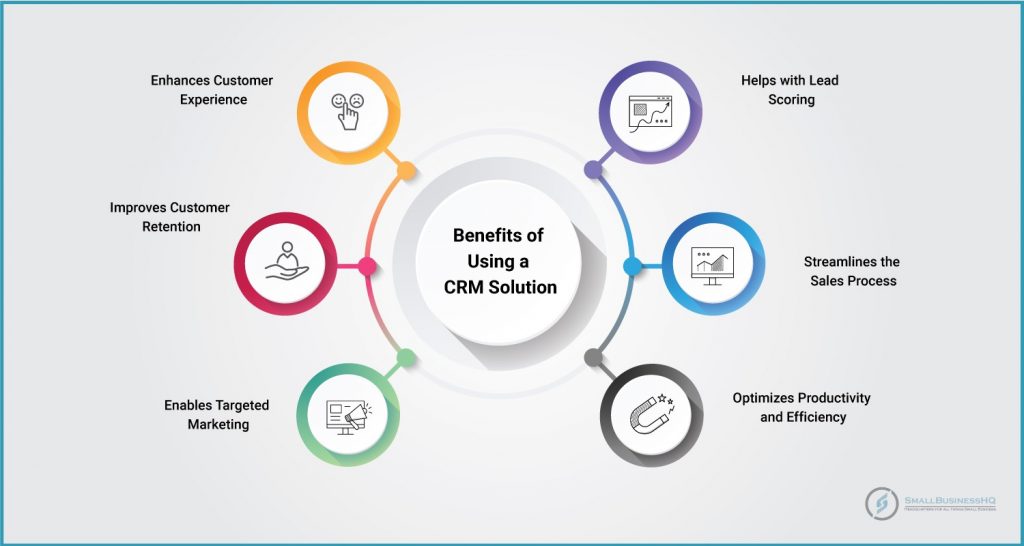
Enhances Customer Relationships and Experience
When exploring the “What is CRM?” topic, it’s important to consider how it enhances the customer experience. As mentioned earlier, using a good CRM solution is what helps you deliver exceptional customer service and experiences.
How does it do that?
Customer relationship management provides your front-end employees with valuable information about each customer, including their purchase history, complaints, feedback, and more.
And whenever any employee starts a customer interaction, they can access the customer’s profile and personalize their conversation. This helps sales teams provide better service throughout the entire customer journey.
Here are a few practical applications of CRM for enhancing customer satisfaction:
- Using insights from CRM, you can find engaging ways to keep in touch with your existing customers by sending them personalized updates, recommendations, offers, and more.
- By analyzing customer complaints and feedback, you can better understand their needs so that you can meet them.
- You can personalize your interactions with every customer to make them feel special and to build strong relationships with them.
- Use the data from past interactions to provide better customer support and quick problem resolution to improve the customer experience.
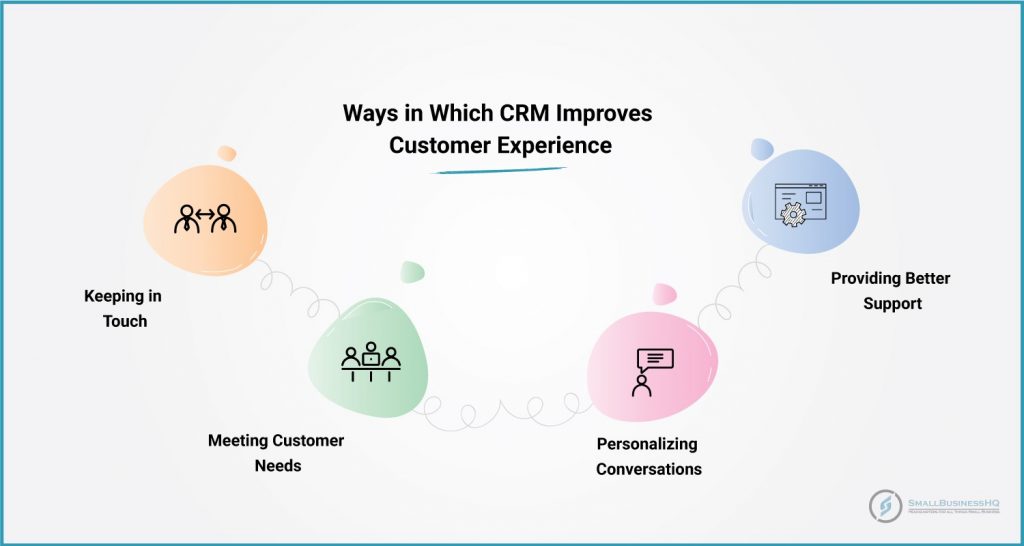
Hopefully, this answers your question regarding the point of investing in a CRM and encourages you to go for it.
Still not convinced?
Let’s discuss some of the other benefits of using a CRM (customer relationship management) solution to manage your interactions with customers.
You May Also Like:
Improves Customer Retention
Before we discuss how CRM can help with customer retention, let’s first understand some key reasons why customers leave a brand.
Besides poor quality products, which is the biggest reason to leave a brand, here are the two most common reasons:
- Poor Customer Service: Customers are more likely to leave a brand if they don’t get good service consistently. Knowing your customers’ history helps provide excellent customer service.
- Lack of Personalization: A recent study found that customer loyalty is influenced by factors like good services, reliable customer support, and low prices.
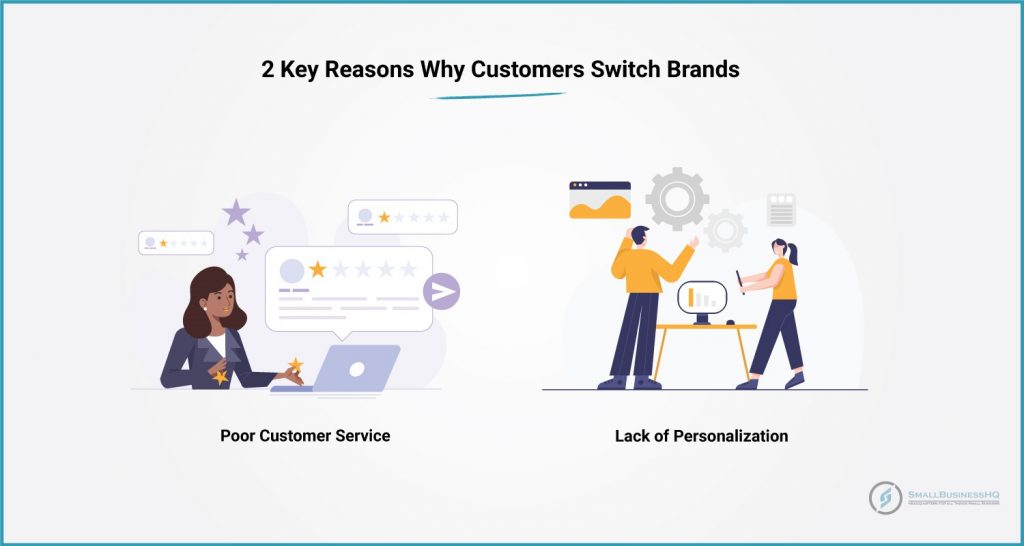
Brands are mostly competing based on customer satisfaction rather than actual products. Good-quality products are a given, but customers today want more than that—they want personalized interactions and quick problem resolution.
What customer relationship management does on this front is help you provide consistent and personalized service across channels, improving your customer experience and, in turn, retention. This is crucial for developing meaningful customer relationships and building customer loyalty.
Enables Targeted Marketing
What is the main purpose of using a CRM (customer relationship management) platform?
To get in-depth, accurate, and timely customer information and insights…right?
Well, that also happens to be the most important thing you need for creating targeted marketing campaigns.
Here are some of the many customer information points that you can get from a CRM tool:
- Customer name
- Email address, phone number, etc.
- Social media profiles
- Demographics
- Purchase history
- Interaction history
- Complaints/feedback
- Survey responses
- Response to marketing campaigns
Based on this, you can easily understand what your customers’ needs and preferences are and design marketing campaigns that are most likely to resonate with those customers.
You can even create different audience segments and target customers with different marketing campaigns.
CRM (customer relationship management) can help you improve your marketing efforts in the following ways:
- Creating targeted content
- Sending personalized emails
- Creating engaging social media posts
- Building custom offers and promotions
- And a lot more!
It Helps With Lead Scoring
CRM can not only help you segment your prospects and customers, but can also prioritize them based on how likely they are to make a purchase.
Many sales professionals would agree that wasting time on unprofitable leads is both time-consuming and annoying.
Using a customer relationship management software solution can help you overcome this CRM challenge by using lead scoring.
What is lead scoring?
It’s a technique in which you analyze your sales leads and give them scores based on how likely they are to convert.
What this means is that prospects with a high purchase intent will get high scores, while those who were just casually checking your products will get low scores. This can help your sales reps focus on the most promising potential customers.
So what is the point of performing this segmentation?
Lead scoring can help you prioritize your marketing and sales efforts on the most profitable leads first. This will, in turn, improve the effectiveness and conversion rate of your sales team.
Streamlines the Sales Process
Understanding the “What is CRM?” concept in the context of sales is crucial. A CRM software solution makes the entire sales process more streamlined and efficient.
As soon as new customers enter your sales cycle, you can track their journey using the data points from your customer relationship management system.
Moreover, when leads are ready for conversion, the marketing team can seamlessly hand them over to the sales team so that everyone is on the same page and has access to the same CRM data.
Basically, what a customer relationship management does is help you streamline the process by offering more visibility to teams and letting everyone see where a prospect is in your sales funnel.
Optimizes Productivity and Efficiency
A CRM solution allows the different teams within your organization to collaborate better.
As you know, different teams are involved in different stages of a customer lifecycle. By integrating all customer data in one place, CRM can enable different teams to be on the same page and to do their jobs more efficiently.
A study by Gallup conducted between 2001 and 2023 showed that employee disengagement continues to rise. This is mainly because employees are fast losing sight of their roles.

Image via Gallup
All these problems can be solved by an integrated customer data and analytics platform, which is exactly what a CRM offers.
CRM’s benefits go beyond customer satisfaction and also help organizations perform better in their day-to-day operations.
That’s not all!
Many customer relationship management software offer marketing automation features that you can use to further boost your team’s efficiency. These features help automate repetitive tasks, allowing your sales and marketing teams to focus on more strategic activities.
Now that you can comfortably answer the “What is CRM?” question and the benefits it offers, let’s discuss the different types of CRM.
Keep reading!
Also Read:
What Are the Different Types of CRM?
As we dig deeper into the “What is CRM?” topic, it’s important to understand that there are three different types of CRM systems, each serving specific business needs.
Let’s discuss each in more detail to help you understand which one is best suited for your requirements and can help you manage customer data most effectively.
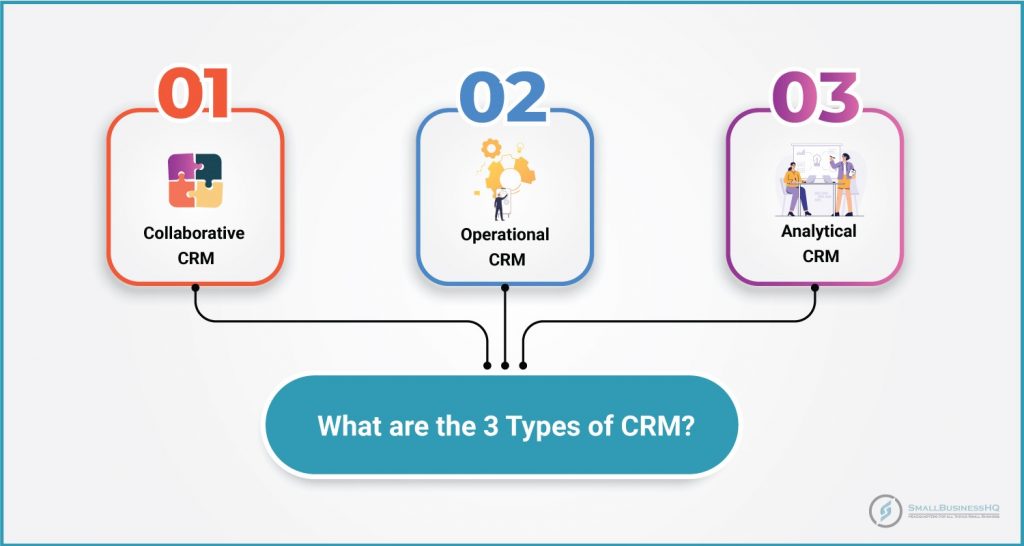
Collaborative CRM
As the name suggests, a collaborative CRM system aims at breaking down organizational silos to help teams collaborate better. This is particularly useful for marketing and customer service teams that need to share information seamlessly.
Sometimes the various teams within an organization are separated by location. Other times, they just work separately, even if they’re physically in the same location.
The main problem that hinders collaboration is that each team works on different systems and has access to different information.
So what does a collaborative CRM software solution do to remedy such situations?
Well, it provides a single, integrated source of information for all teams. This way, everyone has access to relevant information, regardless of their location.
As most CRM solutions offer integrated customer data, all CRMs are collaborative in a way. However, operational and analytical CRM software provides more features as well.
What is CRM and what do they do?
Let’s find out.
Operational CRM
An operational CRM helps you track and visualize a customer’s journey and optimize your customer interactions accordingly.
It aims to improve the marketing, sales, and customer service processes by providing useful and timely information.
More than that, an operational CRM provides automation features that can automate routine and repetitive tasks. This enables your employees to focus on the more important aspects of their jobs.
Analytical CRM
The main focus of analytical CRM software, as the name suggests, is to analyze customer data and provide insights based on that. It goes a step further from collaborative CRM as it not only collects and organizes data, but also dissects it.
What’s more?
It can help you find common customer problems, see trends in customer buying behaviors, give insights into customer preferences, and more. This type of CRM is particularly useful for businesses looking to improve their marketing efforts and identify sales opportunities.
Also Read:
How to Choose a CRM Solution
So far, we’ve covered the burning “what is CRM?” question, why it matters, and what the different types of CRM are. Now, we’ve arrived at the most important part: how to evaluate the best CRM software for your business.
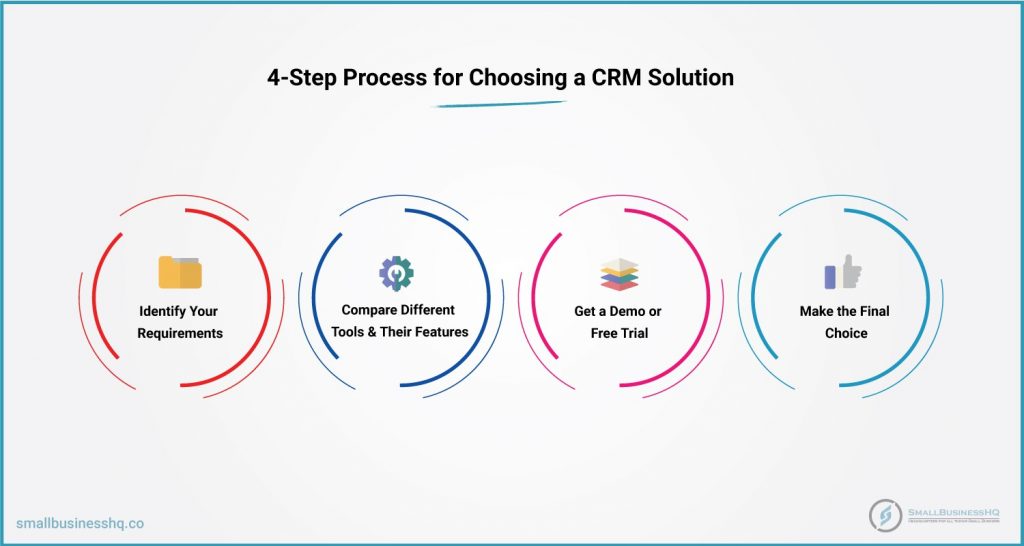
Identify Your Requirements
The first step towards CRM software selection is identifying what your requirements are.
Why?
It’s easy to get dazzled by the features offered by a tool and invest in it only to realize later that you never actually use all of those features.
So, it helps to identify and list your requirements before you begin your software search process. Your requirements will mostly depend on:
- The size of your business
- Your industry or niche
- The type of business you have
- Your budget
- The length & complexity of your sales pipeline
For example, if you have a small business with a fairly short sales pipeline, you can opt for a basic CRM just to manage and organize your customer data.
If you have a large business with multiple teams dealing with customers throughout their journey, however, you may want more collaborative features to manage customer data effectively.
Similarly, for a business with tons of customer data and no way to analyze it, an analytical customer relationship management with advanced features will be needed.
So first, understand your business requirements and then start your search for the best CRM software. You will easily find a list of options through a simple Google search. Once you have that, move on to the next step.
Compare Different Options and Their Features
Once you have a list of options to choose from, you need to compare them based on their features and capabilities. Remember to look for the features that you need rather than going for the most premium CRM tools that offer tons of features you won’t ever use.
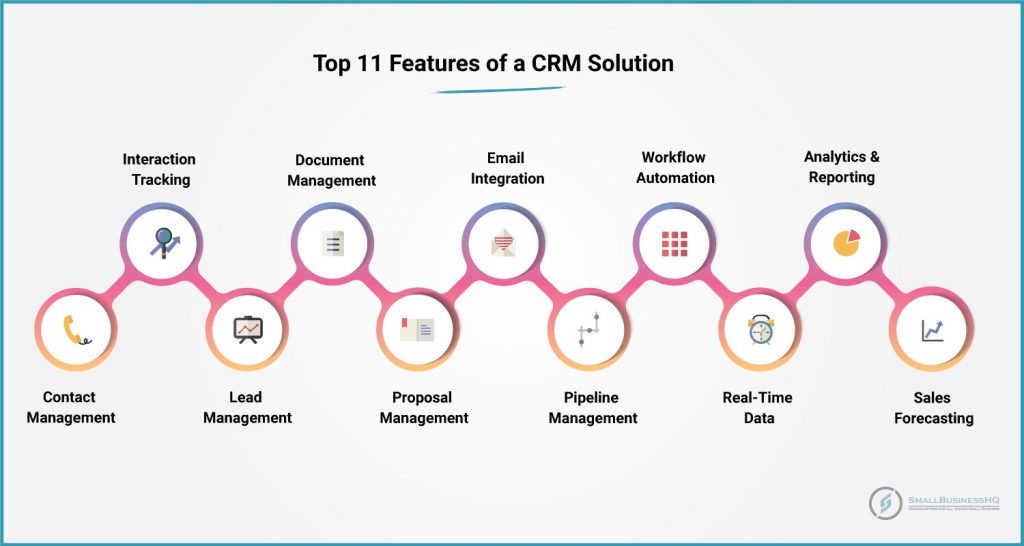
Here is a list of features, starting from the most basic to the most advanced. Take your pick of the essential CRM features that you require and then compare the CRM tools that offer those features and are within your budget.
Let’s get started.
Contact Management
This is a basic feature that almost all CRM software will offer. A CRM solution that not only stores customer information but organizes it well is very useful.
The point of comparison here will not be the feature itself, but how user-friendly the layout or dashboard is. Can you quickly find what you’re looking for?
Since every customer relationship management solution will provide this feature, check the ease of use to shortlist the best ones.
Interaction Tracking
This is another common feature that almost all CRM platforms will offer.
What is interaction tracking?
It is a feature that allows you to track every interaction a customer has with your business across platforms. It helps you understand and remember each customer’s interaction history, which enables you to provide a better experience for them and improve customer engagement.
It also enables multiple teams to collaborate better and deliver a consistent customer experience across channels.
Lead Management
There are a lot of steps involved in lead generation, nurturing, and conversion. CRM can help you gain greater visibility into each customer’s buyer journey. This feature is crucial for sales teams to effectively manage and convert potential customers.
Check the customer relationship management features specific to identifying, scoring, and moving leads down the sales funnel. The key here, again, is to compare how easily you can manage your leads using the CRM system.
Choose the platform that is easiest for you to use and improves your productivity.
Document Management
Document management is another basic feature that you will find in most of the options you may be considering.
What does this feature do?
As the name suggests, it allows you to collect, store, and organize documents in a central location that can be easily accessed by different teams.
If you have a large team, then this is a must-have feature for your business.
Proposal Management
This deals with sending quotes or proposals to prospective clients. It basically allows your sales team to track information about any client easily and send proposals on time.
This is a useful feature, especially if your business requires some back-and-forth with proposals and contracts.
Email Integration
This is just one of those CRM features that makes your life a whole lot easier.
As a business owner, you must know what it’s like to forget to send timely emails or respond to customer emails quickly. You should understand how inconvenient it can be and how it can make you lose important leads.
Integrating your email with your customer relationship management platform just makes it easier for you to manage your email communications from a single dashboard.
Pipeline Management
Managing a sales pipeline is one of the most crucial tasks for your sales team that can be well-managed using a good CRM platform.
A good CRM platform will provide you with complete visibility over your entire sales process. With that visibility, you can see each customer or prospect and where they are in your sales pipeline.
What’s so important about that?
Well, it helps you manage each prospect according to their position in the pipeline and avoids losing leads as a result of a late response.
This feature is practically essential for businesses with a long sales pipeline and a direct sales component.
So far, we have discussed some of the basic or common features offered by most CRM software. Now, it’s time to discuss some of the more advanced features.
Keep reading to find out what they are.
Workflow Automation
What is workflow automation?
It is an advanced feature that allows you to automate repetitive tasks for your sales and marketing teams.
This allows your employees to focus on more important tasks and leaves the basics to technology. These could be reminders or alerts, automated responses to customers, follow-up messages and emails, and more.
This feature is mostly available in advanced or premium tools or in higher-tier packages of most tools.
Real-Time Data
While most customer relationship management software collects and stores customer data from multiple sources, not all of them provide real-time data.
What is the importance of real-time data?
It allows you to make quicker and more accurate decisions than you would otherwise based on historical CRM data. After all, in a fast-paced business environment, it all comes down to timing.
Analytics & Reporting
This is a feature that you will find in analytical CRM but not in the basic collaborative ones.
Whether you want analytics capabilities or not will depend on your requirements. If you have a small business with a limited number of customers and customer data, then a CRM tool with simple reporting capabilities would do.
However, for large businesses with many customers, investing in a top-notch analytical CRM software solution makes sense to gain insights into future CRM market trends.
What is the process for comparing different options?
First, check the kind of analytics each platform provides and how they report them. Platforms that provide easy-to-understand visual reports are better. Further, tools with a wider range of functions are more likely to provide more specific insights.
Also, keep in mind that not all platforms will provide the same level of analytics, even if they claim to be analytical customer relationship management platforms. So, compare the number and quality of metrics and reports available on each platform.
Sales Forecasting
This is another advanced feature offered by premium tools.
So what is it and how does this help?
CRM software with a sales forecasting functionality can estimate future sales based on your current sales pipeline data.
With it, you can:
- Improve or change your marketing campaigns based on changing customer demand trends
- Focus more on products that are selling fast and maintain enough stock to meet the demand
Also Read:
Get a Demo or Free Trial
So now you’ve learned what is CRM and the important features to consider when choosing a CRM solution and have compared different options.
What’s the next step?
You need to try out the shortlisted platforms and see which one best meets your needs.
How?
Most customer relationship management software will provide a demo or a free trial to help you understand their features and interface. Always try a platform before investing to assess how well it will work for your business.
This is especially important for cloud-based CRM solutions, as you’ll want to ensure the interface is intuitive and the features meet your specific needs.
Now that we’ve cleared that up, let’s move on to the criteria for comparing your shortlisted options. There are three important aspects that you need to consider.
Let’s discuss each in detail.
User Interface
The first and most important criterion is the user interface and how easily you can use the platform.
One option may offer more features but be complicated to use; another might provide all the necessary features that you need and be easy to use.
What would you choose? We recommend the latter.
The reason is simple—you need to be able to use a platform to get the most out of it.
Always try a platform to get a feel of how easy or difficult it is to use and to see if you find the user interface intuitive.
Ease of Implementation
Another aspect that you need to consider is how easy or complex it is to set up the platform within your business processes.
You’ll need to check what resources a company provides to help new customers with the implementation process. Be sure to also check what level of support they will provide to set things up and train your employees.
Salesforce, for example, provides tons of useful information and guides to help with the initial setup. You will find everything you need there to start using the CRM platform with ease.
Integrations with Existing Systems
Last but not least, you should check the number and type of CRM integrations offered by your shortlisted platforms.
A CRM software solution should be able to integrate seamlessly with the other software and applications you use within your organization.
What can integrations do for your business?
They help you expand your customer relationship management functionality or combine related functions. Depending on what your business needs, some important integrations include tools such as accounting, payment processing, subscription management, etc.
Make the Final Choice
Once you have compared the CRM software based on features and ease of use, you should have a clear winner. If not, you might have to choose between 1-2 options.
So, what is the criterion for making the final decision?
If you have two tools that are similar in most aspects, it will likely come down to cost and customer support.
When comparing plans, always make sure that you’re doing a like-for-like comparison by gauging the key features provided within the plan. This is crucial for implementing a successful CRM strategy.
So, what is a CRM strategy, and what costs and customer support should you consider? The CRM strategy is straightforward, but the costs and support options require careful consideration.
But let’s look at each in more detail.
Budget
The CRM software solution you pick should comfortably fit your budget and provide the functionalities you need.
When comparing plans, always ensure you’re doing a like-for-like comparison by gauging the key features provided within the plan. Some tools may charge a little more, but they might offer a lot more features as well.
So do a thorough comparison, then take your pick.
Customer Support
Price, of course, is the obvious factor that most people consider when choosing between two similar options. However, you should also consider the level of customer support a company provides.
What is the process for finding that out?
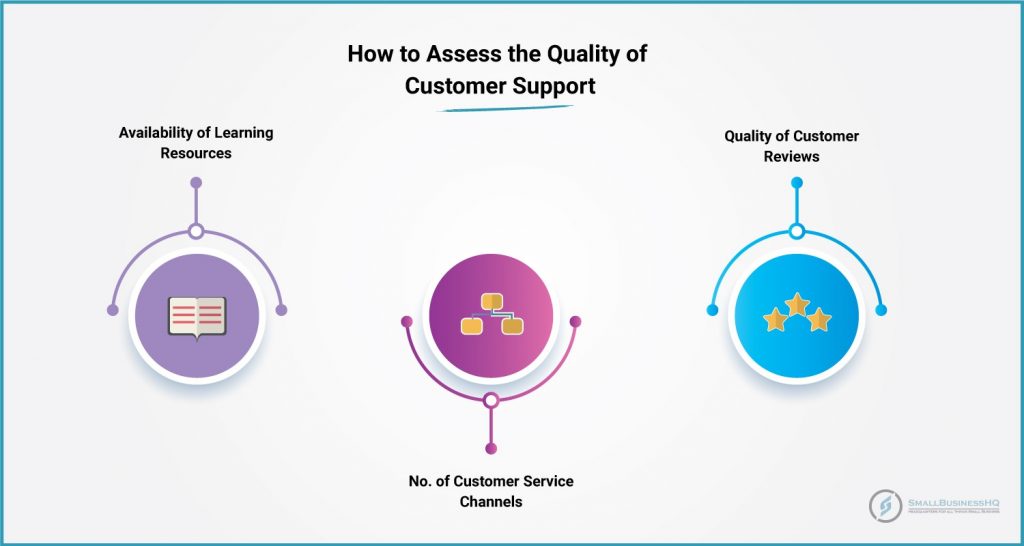
First, check their website and see what kind of online support resources are available. If there are tons of resources like tutorials, guides, etc., then that’s a great sign.
Next, find out how you can reach their customer support team. Some will only provide phone support, while others may be available through multiple channels like email and live chat.
Also, find out how easy it is to reach their customer service representatives. Some companies provide 24/7 customer support while others are only available on weekdays.
Finally, read online reviews of the CRM platform you’re interested in and see what people say about their customer service. Consider customer relationship management software solutions that have more happy customers, because they tend to be better than those with lots of negative reviews.
Compare the shortlisted options on these final two parameters and then make the final choice.
Also Read:
How to Set Up a CRM System
So, you’ve decided which CRM platform best suits your requirements. Now, the next step is to set up your CRM system and start using it.
Here’s a six-step process to do that.
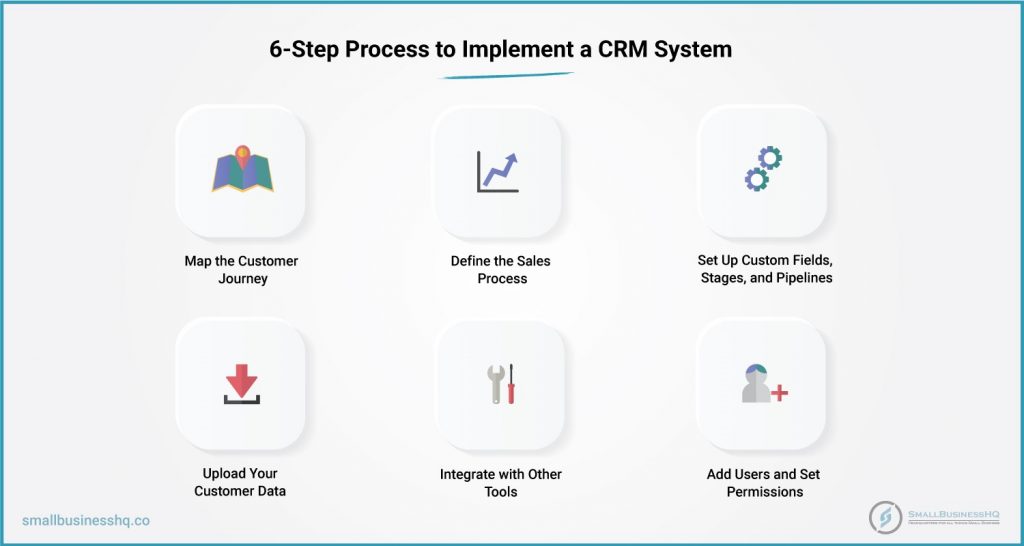
Let’s discuss each step in detail to understand exactly how to set up your CRM system for business success and improve sales productivity.
Map the Customer Journey
Before you even start setting up your CRM, you need to understand and map your customers’ journey through your sales funnel. This helps you understand what you need your CRM to do so that you can set it up accordingly.
Find out the exact tasks that you need your CRM to perform at various stages of a buyer’s journey to enhance customer engagement.
Though the stages of a buyer’s journey remain the same for most businesses, it’s what happens at each stage that differs. What are the customer touchpoints at each stage of their journey? Which forms of marketing communication do you use at different stages?
Here’s an example of a customer journey map:
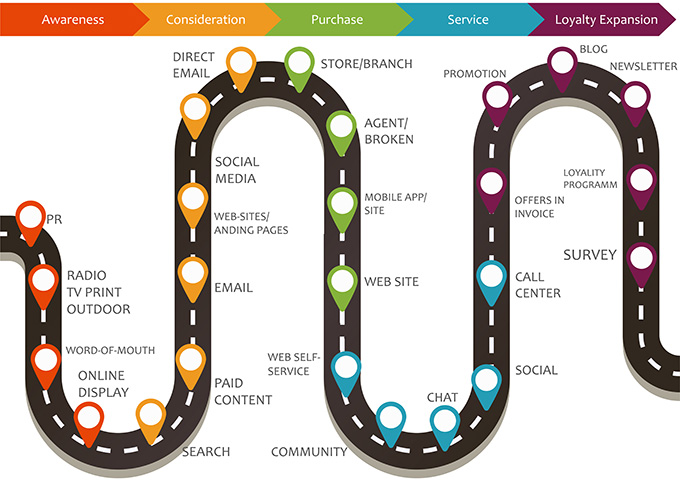
Image via invesp
What is the purpose of doing this?
It helps you understand what you need your CRM to do so that you can set it up accordingly. Find out the exact tasks that you need your CRM to perform at various stages of a buyer’s journey.
Then, move on to the next step.
Define the Sales Process
Where do most of your leads come from? Which pages drive the most conversions? At what point are leads handed over by the marketing team to the sales team?
Ask yourself these questions to understand your sales cycle and exactly how it works.
Why?
Well, you can only set up your CRM to help your sales and marketing teams if you understand your sales process end-to-end.
For example, let’s say that most of your leads come from your website. You can set up your CRM to track the leads from your website, what actions they take on your site, and how they convert.
After all, the core job of a CRM software solution is to capture customer data. You just need to tell it which data points are the most important for you.
Set Up Custom Fields, Stages, and Pipelines
Until now, you’ve simply understood your processes. This is the actual stage where the information gathered in the first two steps will be used to set up your CRM.
You need to set up custom fields for your CRM at this stage.
Custom fields are the different data points that store customer information. Some commonly used custom fields are:
- Name
- Email address
- Date of birth/age
- Phone number
- Date of first purchase/subscription
- Job title
These fields are used to capture information about your customers, so you can choose to add whichever fields are relevant to your business.
Next, you need to set up the various stages of your sales process in the CRM.
The generic stages of a typical sales process range from awareness to conversion. However, you should make these as specific to your business as possible.
For example, if your business deals with direct sales, your stages could be:
- Cold call/initial outreach
- First meeting/product demonstration
- Sending proposal/quote
- Contract review
- Deal validation
You have your stages. What now?
You’ll need to organize the various stages of your sales process into pipelines. Once the objective of a stage is fulfilled, leads can move to the next stage in the pipeline.
One word of caution:
Don’t make your pipelines too complex just for the sake of adding as many stages as possible. Keep things simple to set up your CRM for business success.
Upload Your Customer Data to the CRM
Now comes the most important part—adding your customer data to your customer relationship management platform.
The previous three steps prepared you for this data entry so that your data becomes useful after you migrate it to the platform.
So, what’s the process for migrating your customer data?
The most common way to do this is to import all the data into a .csv file and upload that to the customer relationship management platform. It enables you to import segmented customer lists and tags as well, making the process easy and efficient.
Some CRM platforms also offer the service to handle data migration, so you don’t have to worry about anything.
Once this is done, you need to add customers to the right pipelines to put your CRM to use.
Pro Tip: Use the learning resources provided by the CRM vendor to properly migrate your customer data and add it to pipelines.
Integrate with Other Tools
Now that you have added all the data and set up custom fields and pipelines, you’re a few steps ahead. All you need to do now is integrate it with other tools before you can start using your CRM platform.
Which apps and tools should you integrate with?
Here are some types of integrations you should consider:
- Social media
- Email marketing
- Web analytics
- Appointments and scheduling
- Forms and sign-ups
- Online shopping
When all the systems that you use are integrated with your CRM, it makes the process much more efficient and streamlined.
What’s more?
CRM integrations allow you to capture customer data from various sources. So, the information from all your tools and platforms will feed directly into your CRM to provide a holistic view of each customer. This is particularly useful for sales and marketing activities.
There are three types of integrations that you need to do. Let’s look at each one of them.
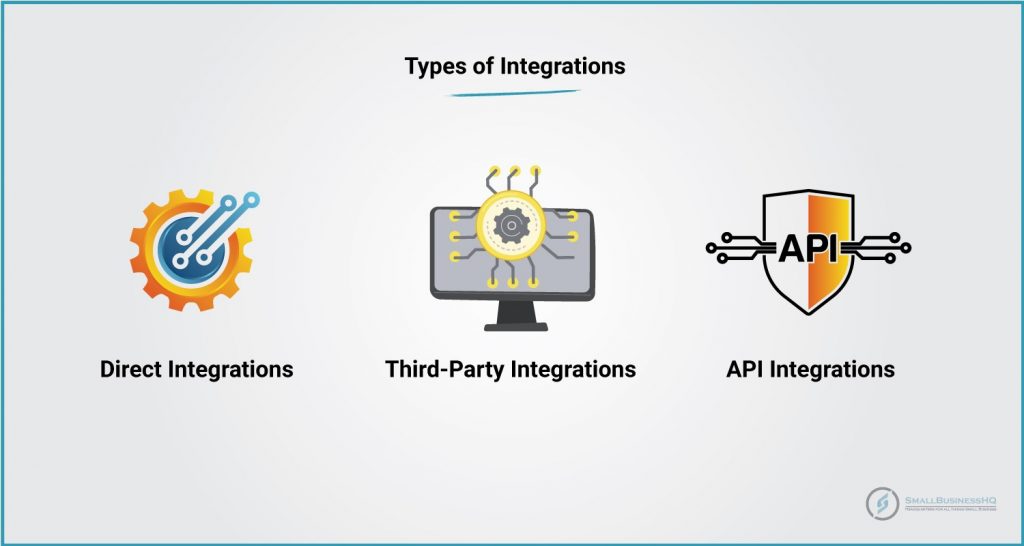
1. Direct Integrations
These are the integrations provided directly by the CRM vendors that can be done from the platform itself.
2. Third-Party Integrations
These are done using a third-party or middleman to connect your CRM with another tool. Such connections would not be possible without a middleman.
3. API Integrations
When you use the platform’s code to make custom connections, those are called API integrations. For this, you need to check to see if your customer relationship management vendor provides API access or not.
Add Users and Set Permissions
Your relevant integrations are now in place. What’s next?
Your CRM is ready to use.
Simply add users to your customer relationship management system and give them access to the relevant information. You can set up permissions to allow only the relevant users access to certain information.
This should be done based on a user’s role and what information they would need to perform their job well.
That’s it!
You not only know what is CRM, now you’re all set to start using your new CRM. But before you do that, you should learn some of the most important best practices for using a CRM solution.
Have a look at what those are in this next section.
Best Practices for Using a CRM Solution Properly
At this stage, you should be ready to start using your CRM platform. You will, with time, make a few mistakes and learn from them.
However, you could also learn the best practices for using a CRM solution the right way and avoid any CRM mistakes to begin with!
These practices will help you build customer loyalty and potentially increase sales revenue.
So, what are these best practices?
Let’s find out.
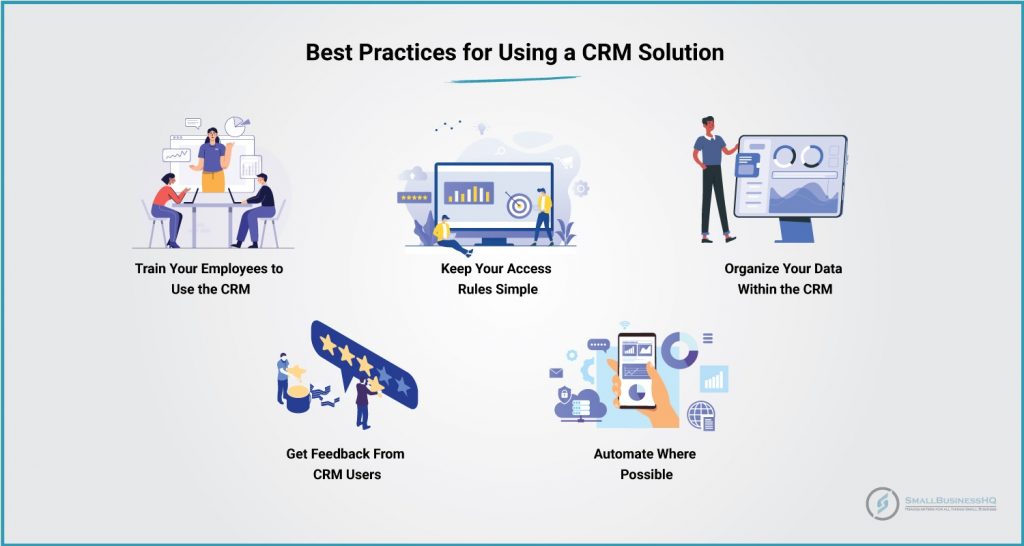
Train Your Employees to Use the CRM
You simply cannot take on a heavy task like implementing a CRM system without training your employees on how to use it. This doesn’t refer to a last-minute crash course on how to use the platform, but rather a comprehensive training program.
Ideally, you should start preparing your employees for the upcoming changes to their day-to-day operations in advance. This is crucial for both sales teams and customer support teams.
A complex customer relationship management system can help manage your entire marketing and sales pipeline. But if you don’t train your employees well, it will just end up being an expensive data storage or filing system.
Avoid that trap! Train your employees well to get the most out of your new CRM platform. This will help your sales teams better manage sales leads and improve overall customer engagement.
Keep Your Access Rules Simple
First, it’s important to set some user permissions for your customer relationship management system, as not everyone should have access to sensitive data.
So, you need to assess who needs access to what level of customer data to do their jobs well and then set those rules accordingly.
This, however, does not mean that you take this segmentation on such a granular level that you are setting different rules for different individuals. The more complex your access rules, the more difficult it will be to track if you have any problems.
So, what should you do?
Set a few levels of access and then segment your employees into those limited categories. This should serve your purpose while keeping things simple.
Organize Your Data Within the CRM
There are two components to this—keeping things organized and tracking any new changes.
If you have set up your CRM system well, then your data will be properly organized within the system.
But remember: you need to ensure that you’re able to track any changes made in your system by setting up notifications and alerts.
Get Feedback From Your CRM Users
Once your teams start using the CRM system, ask them for feedback. After all, the actual users will have the deepest insights into what is working and what can be improved.
Take regular feedback from your CRM users to keep improving and optimizing your customer relationship management system further.
Make a special note of process improvements that they recommend as that can be very beneficial for your business.
Automate Where Possible
If your CRM system can automate certain tasks, then use it.
Sales and marketing automation helps save time and makes processes more efficient. If you can automate repetitive tasks, then it will free up your employees’ time to focus on more nuanced work.
The chances of human error are often high for tedious tasks like data entry. Automation can not only help you get things done faster but also more accurately.
FAQ
1. What is CRM and how does it work?
CRM stands for customer relationship management and can be used to refer to both the process and the platforms used for it. More often than not, CRM is the software used to manage customer relationships.
Here’s how CRM works:
Customer relationship management systems work by collecting customer information and data from various sources within an organization.
It collates this data to create detailed customer profiles or personas
Then, it analyzes this data to provide valuable customer insights that can be used for strategic business decisions
Using a CRM, you can access detailed information about any customer or do a bulk analysis to score leads, streamline the sales process, and more.
2. What are the 3 types of CRM?
The three types of customer relationship management (CRM) platforms are:
- Collaborative CRM: Aimed at providing a single source of information to all teams for better collaboration.
- Operations CRM: Focuses on improving operations and sales processes by automating tasks
- Analytical CRM: Provides in-depth customer insights to fuel strategic business decisions.
Choose the right type of CRM based on your business requirements instead of thinking that a high price signifies a better fit.
3. What is a CRM system example?
Salesforce is a good example of a CRM system. It is used to manage customer data and improve customer relationships and experiences.
There are many good CRM platforms available on the market. However, no one platform can be the best option for every business.
So, identify your requirements first and then choose the best solution that meets those requirements.
4. What type of software is CRM?
It is a kind of data tracking and management software used for managing customer data. CRM technology is one of the most important parts of any business, as it integrates with other systems to collect and analyze customer data.
5. Why is CRM needed?
A customer relationship management platform allows businesses to manage their customer data and use it to their advantage.
Many businesses have tons of customer data stored in silos but unused to drive strategic business decisions. A customer relationship management solution allows such businesses to organize and analyze this data to gain valuable insights from it.
6. What is the advantage of CRM?
Here are the key benefits of CRM:
- Enhances customer experience
- Improves customer retention
- Enables targeted marketing
- It helps with lead scoring
- Streamlines the sales process
- Optimizes productivity and efficiency
Using a CRM solution to manage your customer data can be the difference between success and failure for your business. So, identify your requirements and choose a customer relationship management solution that helps you deliver a better customer experience and develop customer relationships.
7. What is the process for CRM software selection?
Here is the step-by-step process for choosing the right customer relationship management tool for your business:
- Identify your business requirements: Which type of CRM do you need, and which features will help your teams perform better?
- Compare different options: Compare the features offered by different platforms and shortlist the ones that best match your requirements.
- Try them out: Get a free trial or demo of your shortlisted options and compare them based on their ease of use and user interface.
- Make the final choice based on considerations like price and the quality of customer support offered by different vendors.
8. What are the important features of CRM software?
Here are some of the key features of customer relationship management software that you can use to compare different options:
- Contact Management – Capturing, organizing, and using the customer contact information to help aid business processes.
- Interaction Tracking: Tracking customer interactions with a business and maintaining a profile of each customer and their histories.
- Lead Management: Aiding lead generation, nurturing, scoring, and conversion processes for a business.
- Document Management: Storing and organizing all important documents for specific teams and making it easy for relevant users to access them.
- Proposal Management: Optimizing the process for sending proposals and tracking the status of different clients and proposals.
- Email Integration: Integrating with an email marketing automation platform to send automated emails and responses to customers.
- Pipeline Management: Managing and optimizing the entire sales pipeline end-to-end, from lead generation to conversion.
- Workflow Automation: Automating routine tasks to create efficient workflows.
- Real-Time Data: Tracking customer interactions with a business in real-time and providing updated data to drive business decisions.
- Analytics & Reporting: Analyzing customer data to provide valuable insights in the form of easy-to-understand reports.
- Sales Forecasting: Predicting future sales based on the current pipeline and customer data.
9. What is the difference between CRM and ERP?
While both systems work in a similar way—collecting and organizing customer data—the key difference between the two is the end-users. ERP is mainly used by the financial department while CRM is used by the marketing, sales, and customer service teams.
ERP deals with customers’ financial data, while CRM integrates all customer data to provide a more holistic view.
10. What is the best CRM platform?
There is no one platform that can suit every business’ unique requirements. So, you need to find the answer for your business by comparing the different options available.
Some of the most popular platforms, however, are Salesforce, Keap, HubSpot CRM, and Zoho CRM.
Also Read:
Conclusion
Hopefully, by now you’ve got your answers to the important questions about CRM like:
- What is CRM?
- Why should you invest in it?
- How can you best use it for your business?
- And more!
Now, it’s time to do the hard work of finding the best CRM platform for your business using the selection guide mentioned above. First, identify your requirements, and then compare the most suitable platforms to find the one that best fits your needs.
Whether you’re looking to manage marketing campaigns, implement sales force automation, or simply improve customer satisfaction, the right CRM can help you achieve your goals.
Be sure to follow CRM best practices for implementing and using a customer relationship management platform to get the most benefits from it. All the best!





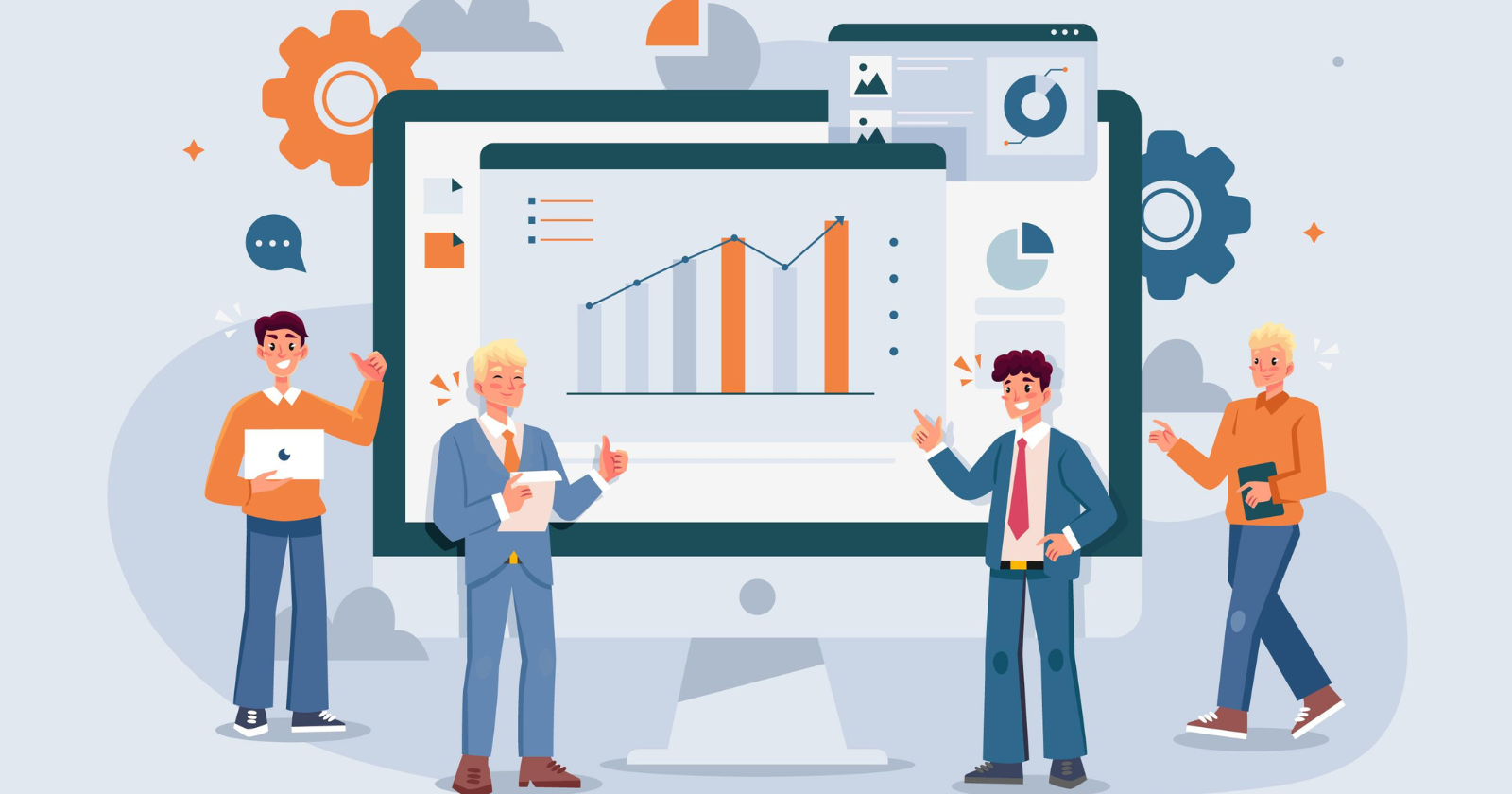
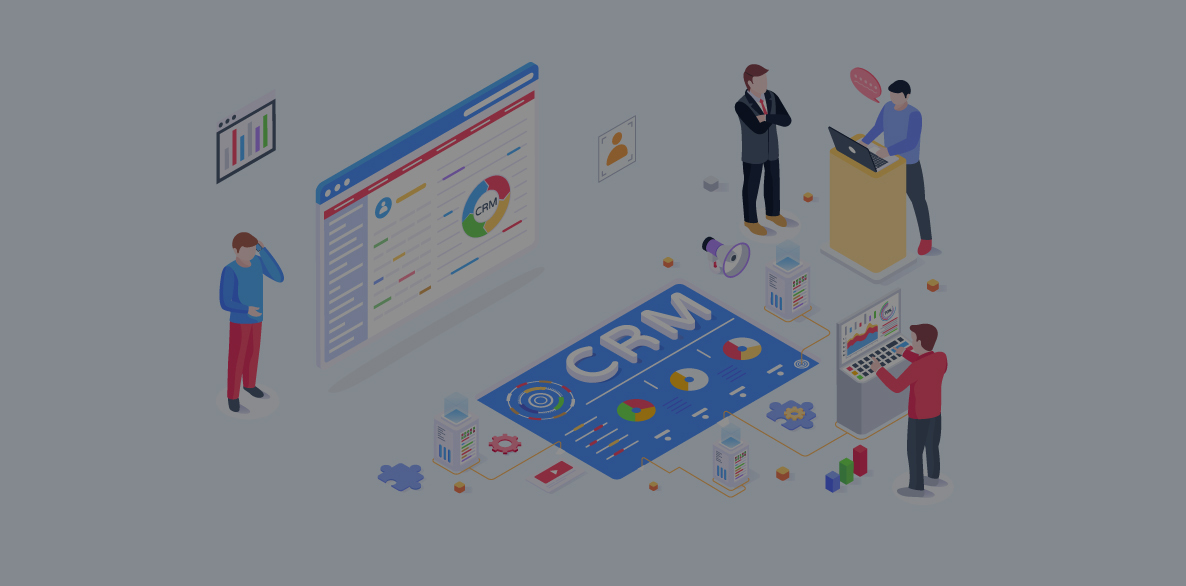
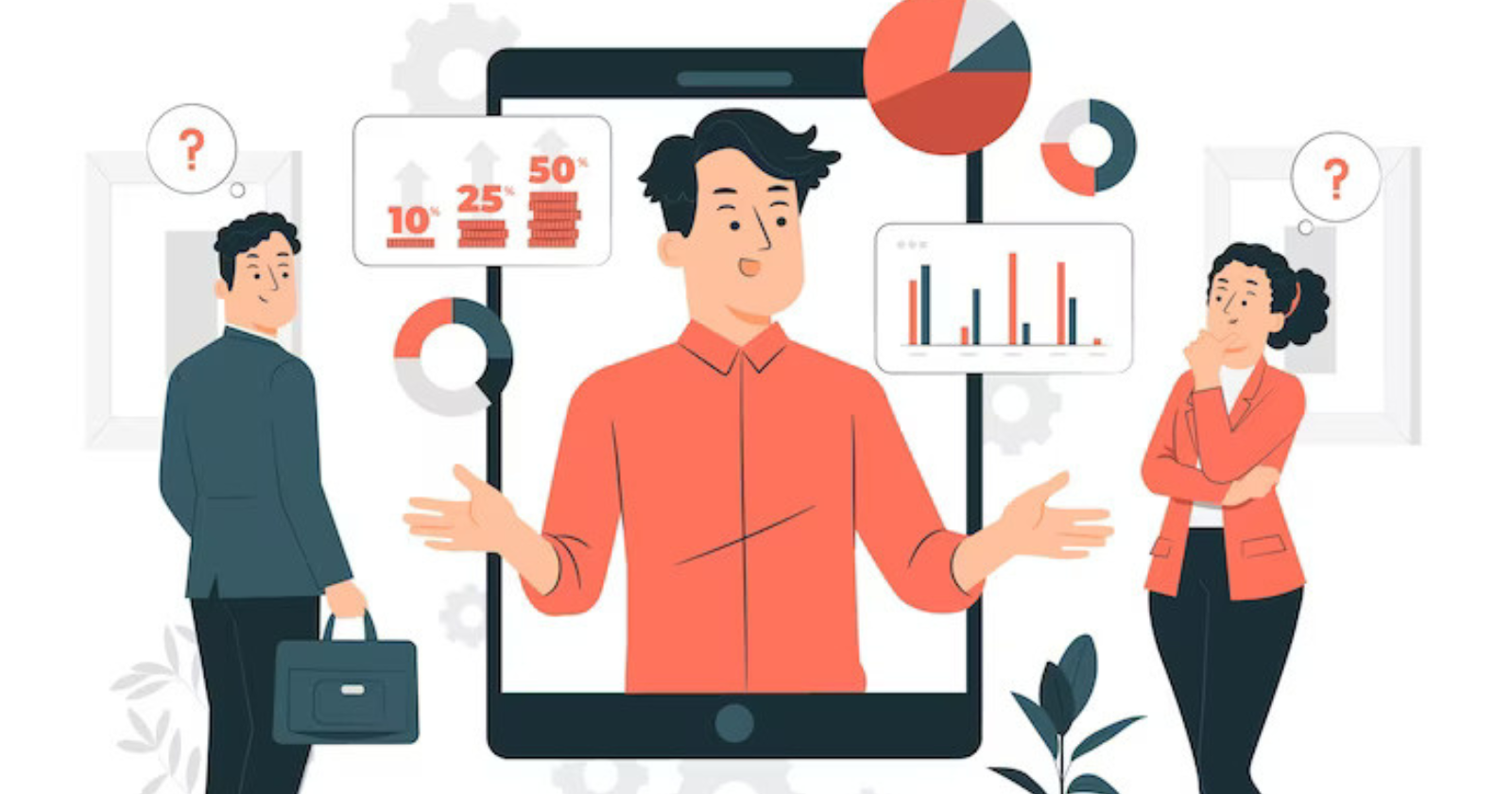
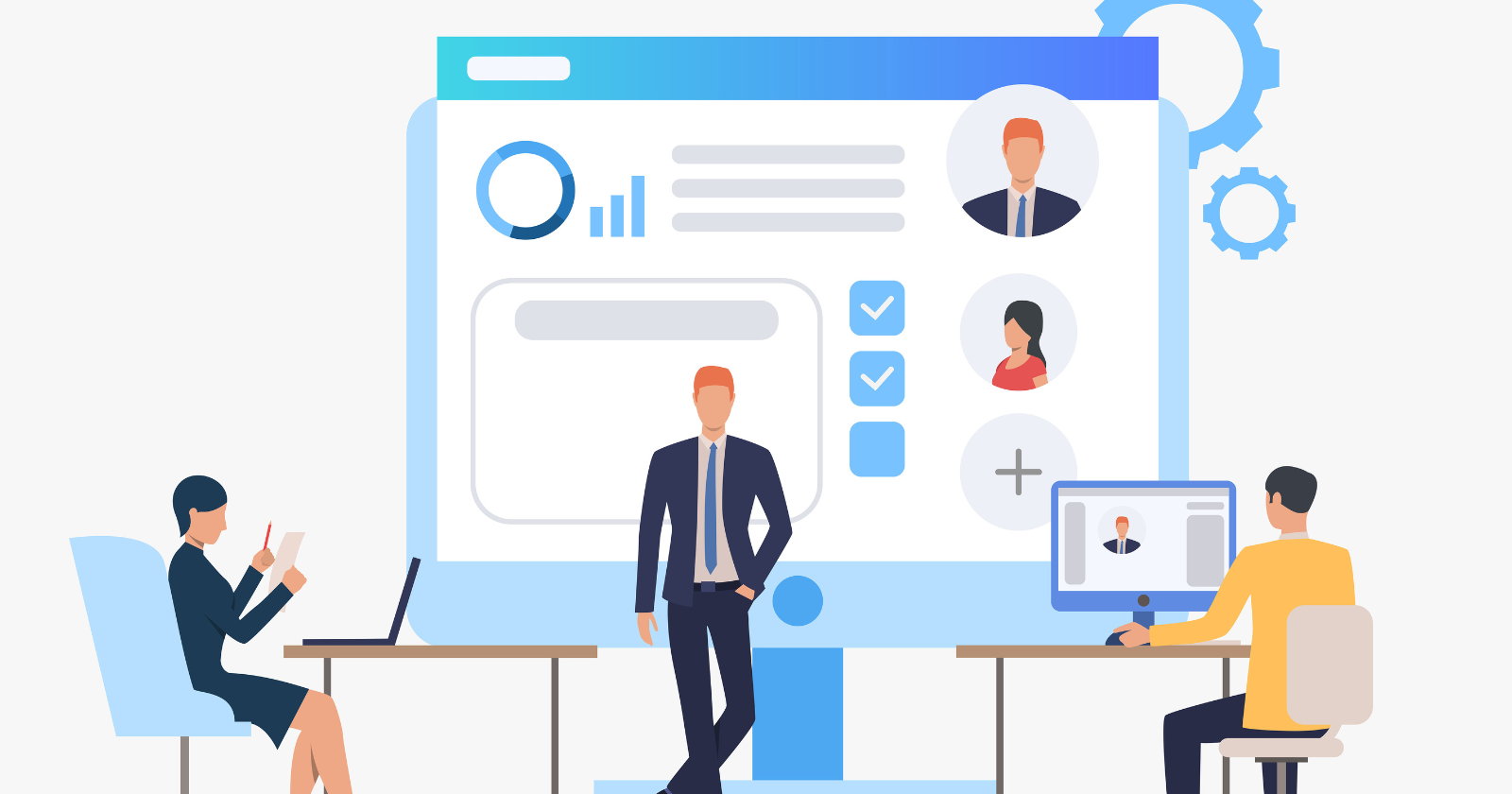



One Response
I found this article super helpful & insightful. Thank you for sharing such a great content.